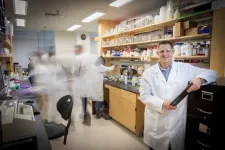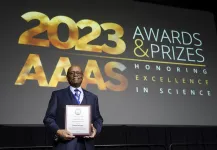(Press-News.org) CAMBRIDGE, MA -- Materials known as metal-organic frameworks (MOFs) have a rigid, cage-like structure that lends itself to a variety of applications, from gas storage to drug delivery. By changing the building blocks that go into the materials, or the way they are arranged, researchers can design MOFs suited to different uses.
However, not all possible MOF structures are stable enough to be deployed for applications such as catalyzing reactions or storing gases. To help researchers figure out which MOF structures might work best for a given application, MIT researchers have developed a computational approach that allows them to predict which structures will be the most stable.
Using their computational model, the researchers have identified about 10,000 possible MOF structures that they classify as “ultrastable,” making them good candidates for applications such as converting methane gas to methanol.
“When people come up with hypothetical MOF materials, they don’t necessarily know beforehand how stable that material is,” says Heather Kulik, an MIT associate professor of chemistry and chemical engineering, and the senior author of the study. “We used data and our machine-learning models to come up with building blocks that were expected to have high stability, and when we recombined those in ways that were considerably more diverse, our dataset was enriched with materials with higher stability than any previous set of hypothetical materials people had come up with.”
MIT graduate student Aditya Nandy is the lead author of the paper, which appears today in the journal Matter. Other authors are MIT postdoc Shuwen Yue, graduate students Changhwan Oh and Gianmarco Terrones, Chenru Duan PhD ’22, and Yongchul G. Chung, an associate professor of chemical and biomolecular engineering at Pusan National University.
Modeling MOFs
Scientists are interested in MOFs because they have a porous structure that makes them well-suited to applications involving gases, such as gas storage, separating similar gases from each other, or converting one gas to another. Recently, scientists have also begun to explore using them to deliver drugs or imaging agents within the body.
The two main components of MOFs are secondary building units — organic molecules that incorporate metal atoms such as zinc or copper — and organic molecules called linkers, which connect the secondary building units. These parts can be combined together in many different ways, just like LEGO building blocks, Kulik says.
“Because there are so many different types of LEGO blocks and ways you can assemble them, it gives rise to a combinatorial explosion of different possible metal organic framework materials,” she says. “You can really control the overall structure of the metal organic framework by picking and choosing how you assemble different components.”
Currently, the most common way to design MOFs is through trial-and-error. More recently, researchers have begun to try computational approaches to designing these materials. Most such studies have been based on predictions of how well the material will work for a particular application, but they don’t always take into account the stability of the resulting material.
“A really good MOF material for catalysis or for gas storage would have a very open structure, but once you have this open structure, it may be really hard to make sure that that material is also stable under long-term use,” Kulik says.
In a 2021 study, Kulik reported a new model that she created by mining a few thousand papers on MOFs to find data on the temperature at which a given MOF would break down and whether particular MOFs can withstand the conditions needed to remove solvents used to synthesize them. She trained the computer model to predict those two features — known as thermal stability and activation stability — based on the molecules’ structure.
In the new study, Kulik and her students used that model to identify about 500 MOFs with very high stability. Then, they broke those MOFs down into their most common building blocks — 120 secondary building units and 16 linkers.
By recombining these building blocks using about 750 different types of architectures, including many that are not usually included in such models, the researchers generated about 50,000 new MOF structures.
“One of the things that was unique about our set was that we looked at a lot more diverse crystal symmetries than had ever been looked at before, but [we did so] using these building blocks that had only come from experimentally synthesized highly stable MOFs,” Kulik says.
Ultrastability
The researchers then used their computational models to predict how stable each of these 50,000 structures would be, and identified about 10,000 that they deemed ultrastable, both for thermal stability and activation stability.
They also screened the structures for their “deliverable capacity” — a measure of a material’s ability to store and release gases. For this analysis, the researchers used methane gas, because capturing methane could be useful for removing it from the atmosphere or converting it to methanol. They found that the 10,000 ultrastable materials they identified had good deliverable capacities for methane and they were also mechanically stable, as measured by their predicted elastic modulus.
“Designing a MOF requires consideration of many types of stability, but our models enable a near-zero-cost prediction of thermal and activation stability,” Nandy says. “By also understanding the mechanical stability of these materials, we provide a new way to identify promising materials.”
The researchers also identified certain building blocks that tend to produce more stable materials. One of the secondary building units with the best stability was a molecule that contains gadolinium, a rare-earth metal. Another was a cobalt-containing porphyrin — a large organic molecule made of four interconnected rings.
Students in Kulik’s lab are now working on synthesizing some of these MOF structures and testing them in the lab for their stability and potential catalytic ability and gas separation ability. The researchers have also made their database of ultrastable materials available for researchers interested in testing them for their own scientific applications.
###
The research was funded by the U.S. Defense Advanced Research Projects Agency, a National Science Foundation Graduate Research Fellowship, the Office of Naval Research, the Department of Energy, an MIT Portugal Seed Fund, and the National Research Foundation of Korea.
END
Scientists use computational modeling to design “ultrastable” materials
These highly stable metal-organic frameworks could be useful for applications such as capturing greenhouse gases
2023-04-04
ELSE PRESS RELEASES FROM THIS DATE:
Why do females prefer ornate male signals?
2023-04-04
Sexual selection provides an answer to the existence of lavishly ornate signals in animals, but not to the question of why such signals are attractive, why do females prefer the extravagant plumage of peacocks? As part of an international team, researchers at Eötvös Loránd University (ELTE) have shown that the reason is not the presumed wasteful cost of ornaments, as honest signals need not have to be costly at all as long as cheaters would have to pay to fake them. Researchers have developed a general formula to calculate honest equilibrium in any model, independent of the cost ...
How an autism gene contributes to infertility
2023-04-04
RIVERSIDE, Calif. -- A University of California, Riverside, study has identified the biological underpinnings of a reproductive disorder caused by the mutation of a gene. This gene mutation also causes Fragile X Syndrome, a leading genetic cause of intellectual impairment and autism.
The researchers found mutations of the Fragile X messenger ribonucleoprotein 1 gene, or FMR1, contribute to premature ovarian failure, or POF, due to changes in neurons that regulate reproduction in the brain and ovaries. The mutation has been associated with early infertility, due ...
Penn Medicine researchers develop model to predict cardiovascular risk among chronic kidney disease patients
2023-04-04
PHILADELPHIA — Chronic kidney disease (CKD) is a strong cardiovascular risk factor and is often accompanied by hypertension and diabetes. Despite the disease’s prevalence—10 percent of individuals across the globe suffer from CKD—there are limited tools for measuring cardiac risk for CKD patients, until now. A new proteomic risk model for cardiovascular disease was found to be more accurate than current methods of measuring cardiac risk, according to a new study led by researchers in the Perelman School of Medicine at the University of Pennsylvania. The study published today in the European Heart Journal.
The Penn researchers developed ...
Overwhelmed? Your astrocytes can help with that
2023-04-04
How Little-Known Brain Cells Tamp Down Overexcited Neurons During Acute Stress
A brimming inbox on Monday morning sets your head spinning. You take a moment to breathe and your mind clears enough to survey the emails one by one. This calming effect occurs thanks to a newly discovered brain circuit involving a lesser-known type of brain cell, the astrocyte. According to new research from UC San Francisco, astrocytes tune into and moderate the chatter between overactive neurons.
This new brain circuit, described March 30, 2023 in Nature Neuroscience, plays a role in modulating attention and perception, and may hold a key to treating attention disorders like ...
WPI researcher leads project to determine how stretching and blood flow impact engineered heart valves
2023-04-04
Worcester, Mass. – April 4, 2023 – WPI Researcher Kristen Billiar has been awarded $429,456 from the National Institutes of Health to investigate how stretching and blood flow can inhibit or encourage cardiovascular cells to populate and grow in tissue-engineered heart valves.
The three-year project focuses on experimental valves that are not yet used in humans, and the work will expand understanding about how mechanical forces propel cells in the body.
“Existing heart valves have drawbacks, ...
Ethics & Human Research, March–April 2023 Issue
2023-04-04
Articles
Disclosing Conflicts of Interest to Potential Research Participants: Good for Nothing?
Inmaculada de Melo-Martín
The growing commercialization of science has raised concerns about financial conflicts of interest. Evidence suggests that such conflicts threaten the integrity of research and the well-being of research participants. Trying to minimize these negative effects, federal agencies, academic institutions, and publishers have developed conflict-of-interest policies. Among such policies, recommendations or requirements to disclose financial COIs to potential research participants ...
Sekazi K. Mtingwa Honored with AAAS Philip Hauge Abelson Prize at Annual Meeting
2023-04-04
The American Association for the Advancement of Science (AAAS) has recognized physicist and humanitarian Sekazi Mtingwa for his invaluable work in the field of intrabeam scattering and particle accelerator research as well as his tireless efforts to promote accessibility, diversity, and equity in STEM. Mtingwa’s career and achievements exemplified the theme of this year’s meeting? “Science for Humanity.” Mtingwa has worked for many years in close collaboration with the U.S. Department of Energy’s Brookhaven National Laboratory and other science organizations around the world.
According ...
In the United States, public support for redeemability of Black offenders is widespread
2023-04-04
In criminal justice, public belief in redeemability reduces punitiveness and increases support for policy measures like rehabilitation, expungement, and housing and employment opportunities. In a new study, researchers examined the effects of racial attitudes on redeemability—the belief that offenders can change and go on to lead law-abiding lives. Belief in redeemability was high for offenders in general as well as for Black offenders, but White nationalism reduced White people’s beliefs in the redeemability of Black offenders.
The study was conducted by Leah C. Butler, incoming assistant professor of criminal justice at the University ...
New insights into engineering climate smart crops for the future
2023-04-04
New research in the field of plant sciences has made significant advances towards understanding the underlying reasons behind why certain crops are better at generating more yield than others.
The study, published in the journal Science Advances, paves the way for how smart plants could be engineered in the future to improve their productivity and yield.
The research - conducted at the Department of Plant Sciences, University of Cambridge, and led by Dr Pallavi Singh, currently at the University of Essex’s School of Life Sciences - focused on photosynthesis, which is one of the most complicated and important processes that plants use to turn light, ...
Strength training reduces BP when practiced with moderate to vigorous intensity two or three times a week
2023-04-04
Strength training practiced with moderate to vigorous intensity two or three times a week is an effective way to mitigate arterial hypertension (high blood pressure), according to a Brazilian study described in an article published in the journal Scientific Reports.
The mechanisms behind the lowering of blood pressure by aerobic exercise are well studied, but little research has been done on the effects of strength exercise on hypertension along similar lines to this review conducted by researchers at São Paulo State University (UNESP).
Led by Giovana Rampazzo Teixeira, a professor in UNESP’s ...
LAST 30 PRESS RELEASES:
Making lighter work of calculating fluid and heat flow
Normalizing blood sugar can halve heart attack risk
Lowering blood sugar cuts heart attack risk in people with prediabetes
Study links genetic variants to risk of blinding eye disease in premature infants
Non-opioid ‘pain sponge’ therapy halts cartilage degeneration and relieves chronic pain
AI can pick up cultural values by mimicking how kids learn
China’s ecological redlines offer fast track to 30 x 30 global conservation goal
Invisible indoor threats: emerging household contaminants and their growing risks to human health
Adding antibody treatment to chemo boosts outcomes for children with rare cancer
Germline pathogenic variants among women without a history of breast cancer
Tanning beds triple melanoma risk, potentially causing broad DNA damage
Unique bond identified as key to viral infection speed
Indoor tanning makes youthful skin much older on a genetic level
Mouse model sheds new light on the causes and potential solutions to human GI problems linked to muscular dystrophy
The Journal of Nuclear Medicine ahead-of-print tip sheet: December 12, 2025
Smarter tools for peering into the microscopic world
Applications open for funding to conduct research in the Kinsey Institute archives
Global measure underestimates the severity of food insecurity
Child survivors of critical illness are missing out on timely follow up care
Risk-based vs annual breast cancer screening / the WISDOM randomized clinical trial
University of Toronto launches Electric Vehicle Innovation Ontario to accelerate advanced EV technologies and build Canada’s innovation advantage
Early relapse predicts poor outcomes in aggressive blood cancer
American College of Lifestyle Medicine applauds two CMS models aligned with lifestyle medicine practice and reimbursement
Clinical trial finds cannabis use not a barrier to quitting nicotine vaping
Supplemental nutrition assistance program policies and food insecurity
Switching immune cells to “night mode” could limit damage after a heart attack, study suggests
URI-based Global RIghts Project report spotlights continued troubling trends in worldwide inhumane treatment
Neutrophils are less aggressive at night, explaining why nighttime heart attacks cause less damage than daytime events
Menopausal hormone therapy may not pose breast cancer risk for women with BRCA mutations
Mobile health tool may improve quality of life for adolescent and young adult breast cancer survivors
[Press-News.org] Scientists use computational modeling to design “ultrastable” materialsThese highly stable metal-organic frameworks could be useful for applications such as capturing greenhouse gases



